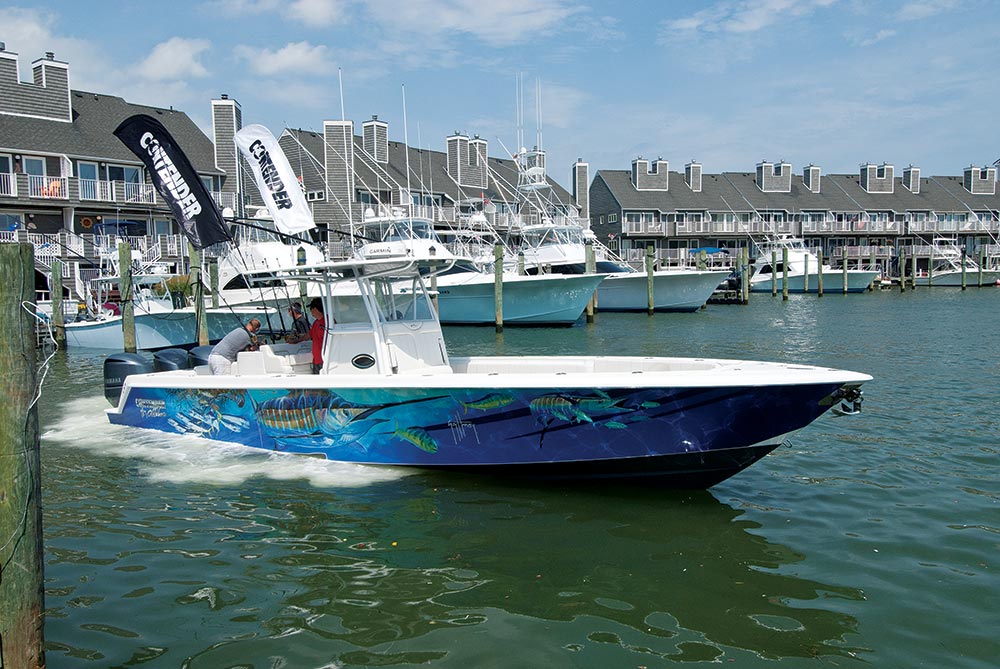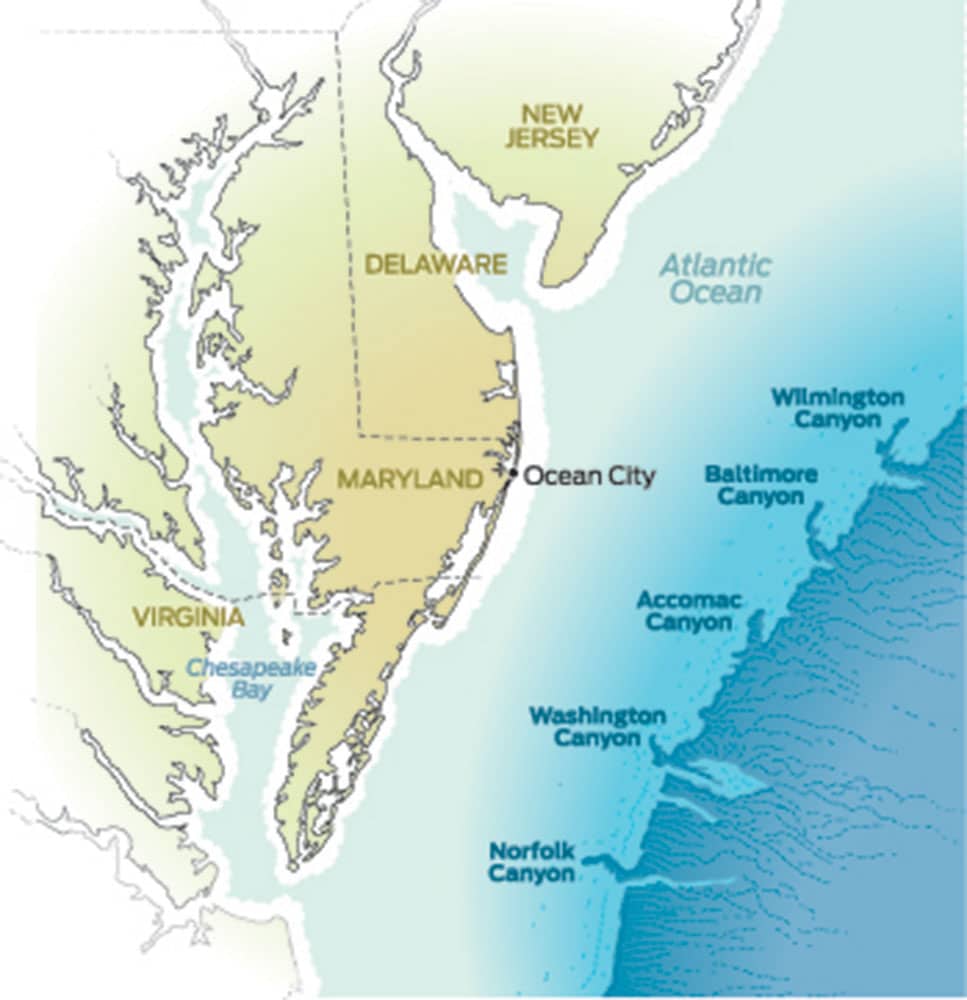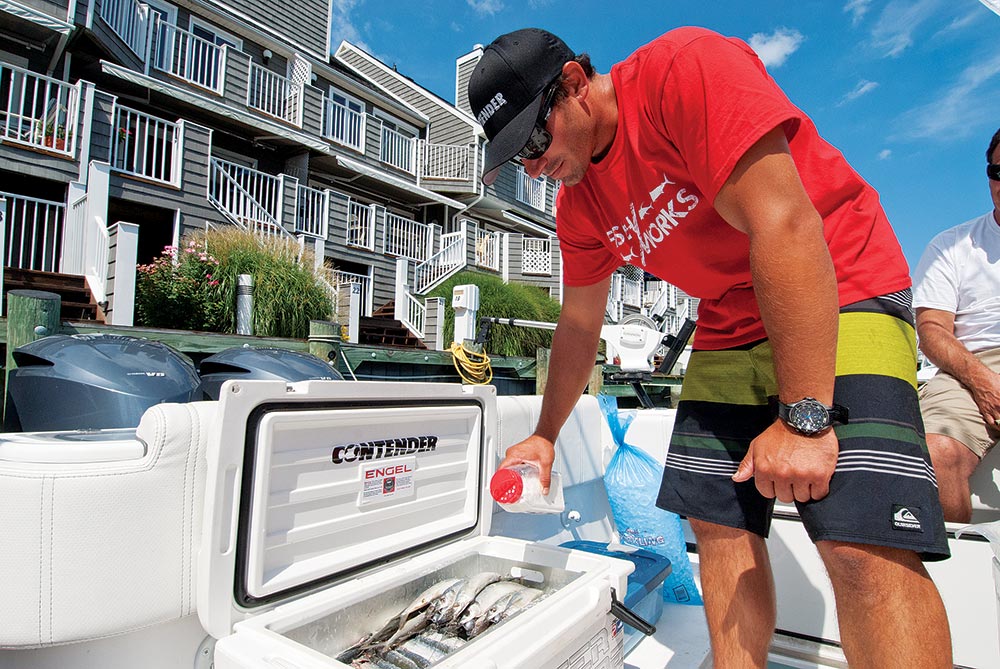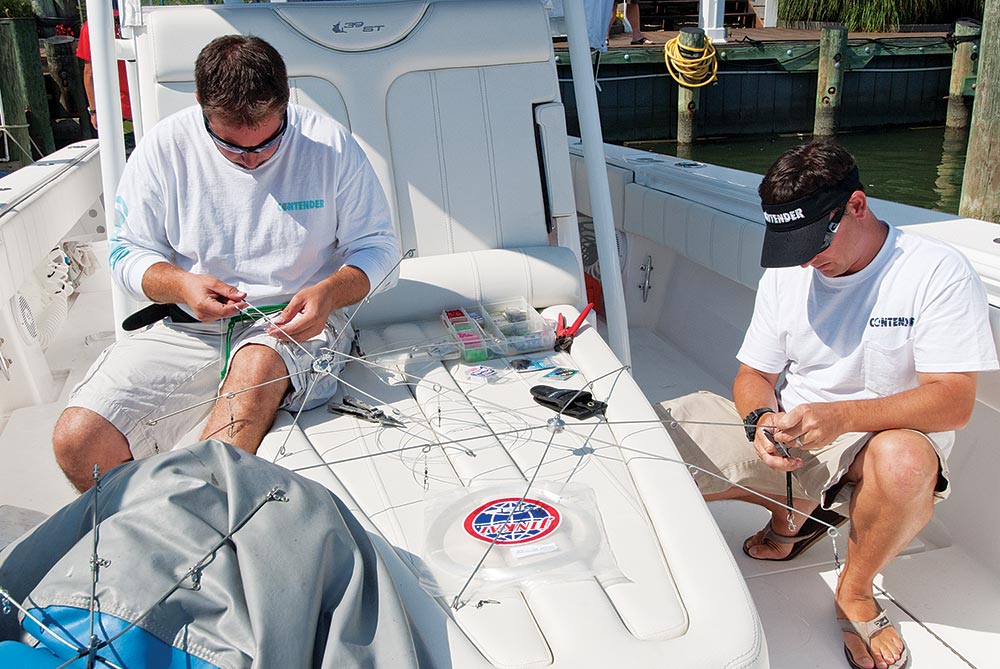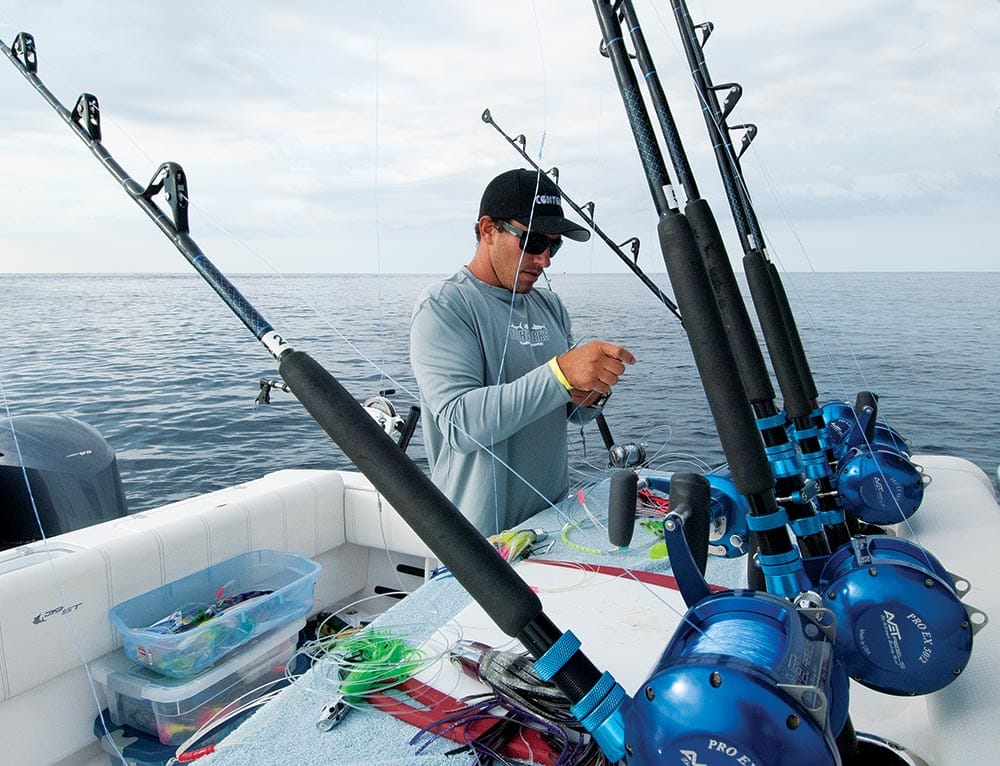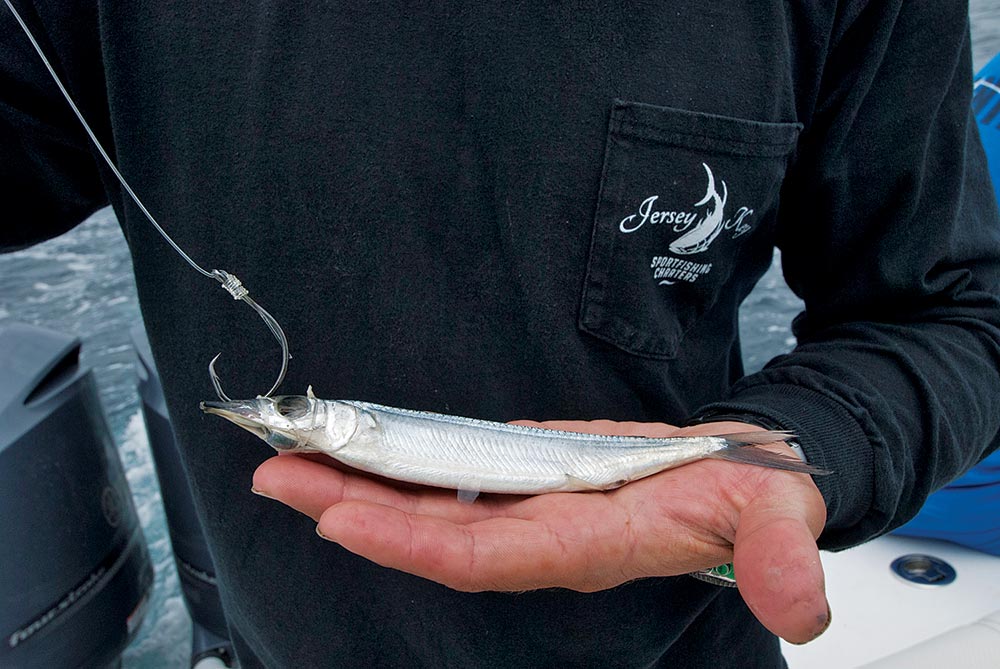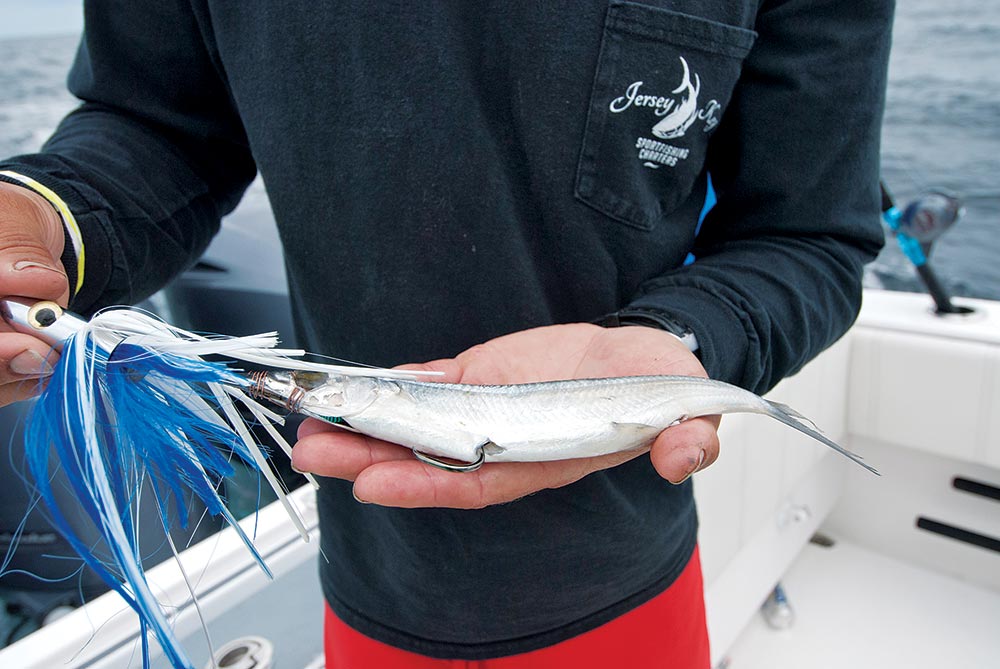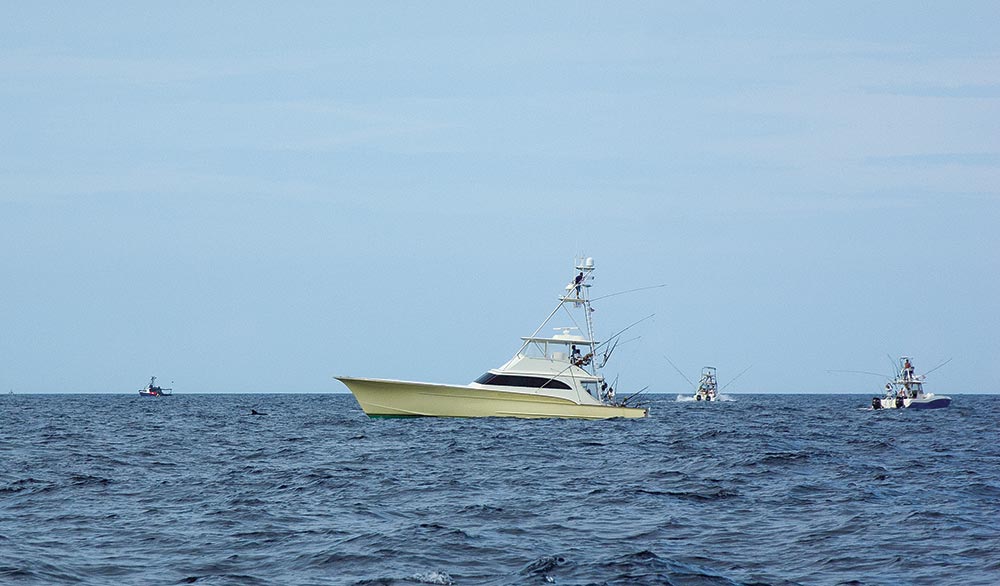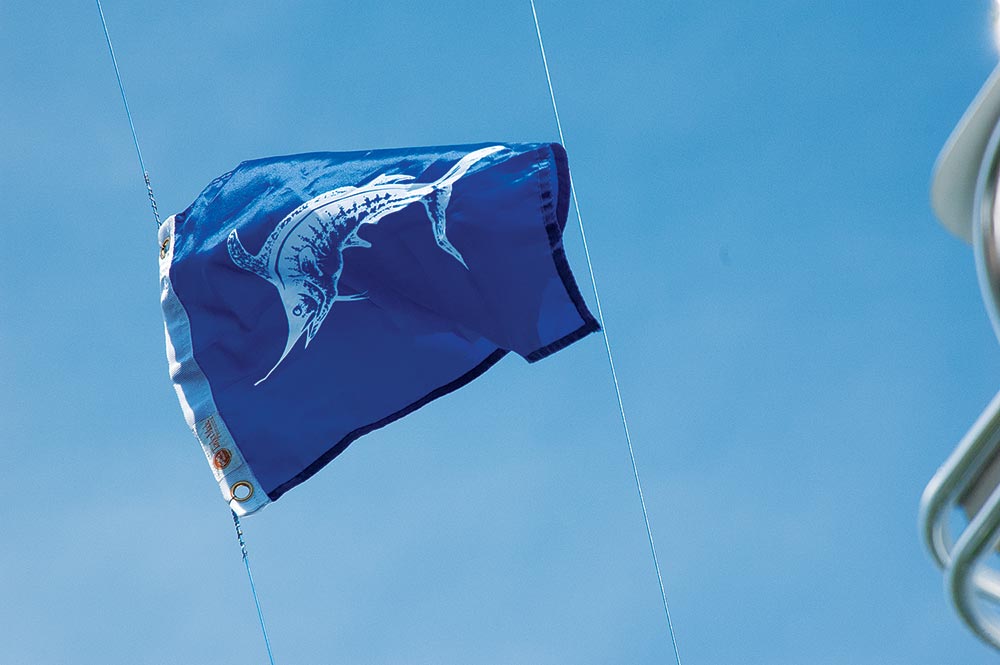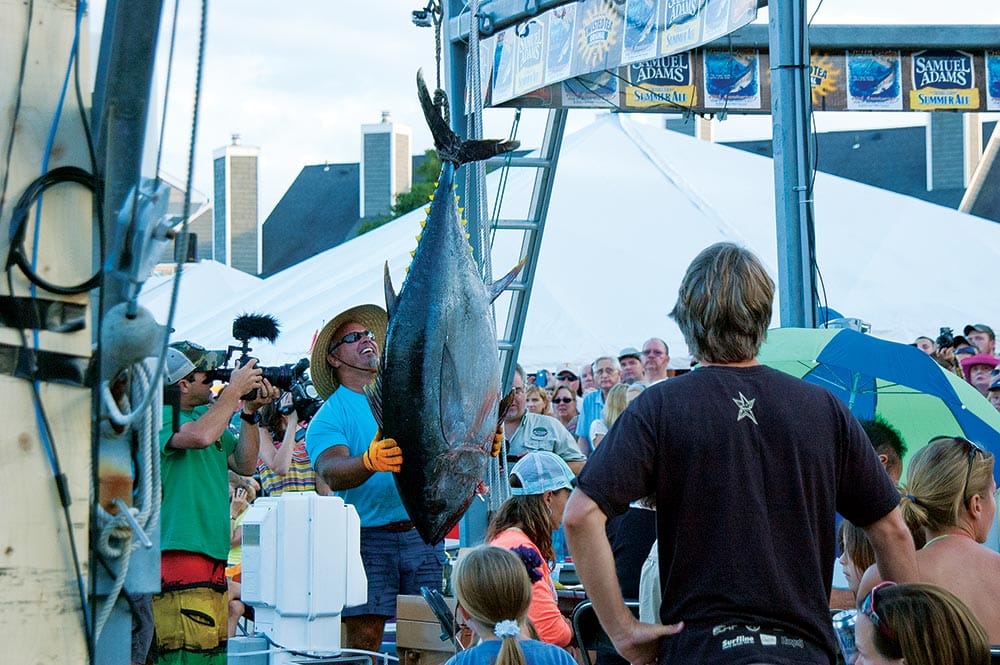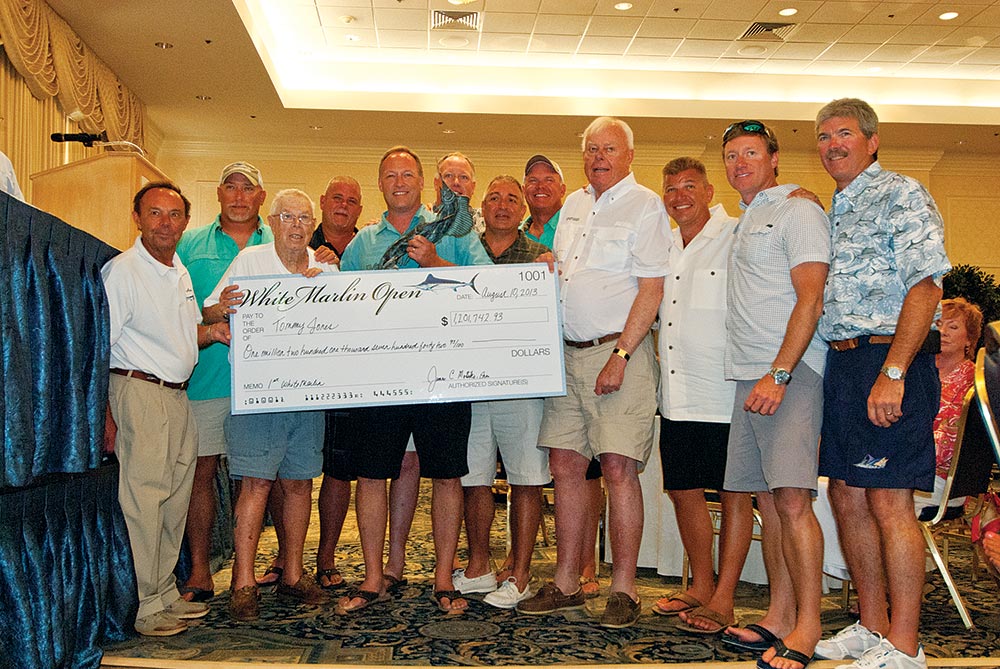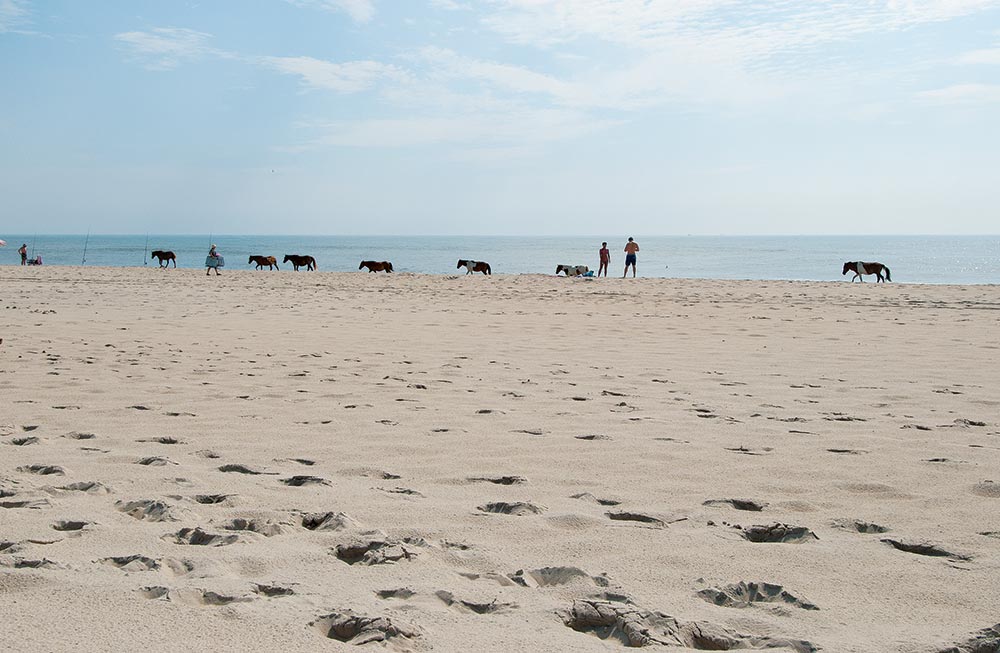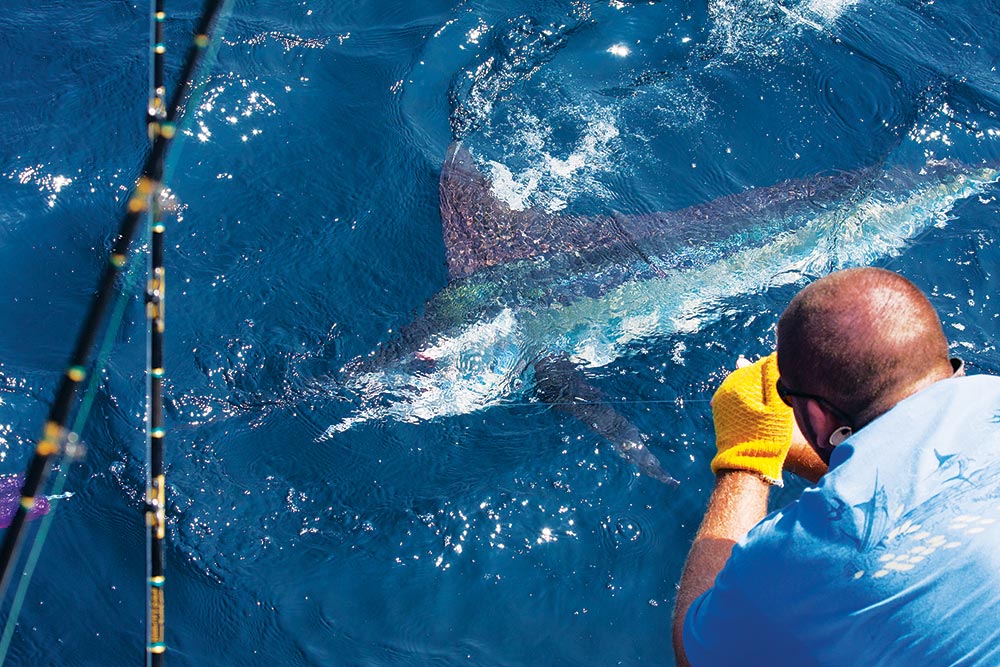
(Be sure to click through all the photos in the gallery above.)
What would you do for $1.2 million?
If your answer is “just about anything legal and ethical,” then consider this: That’s how much an 83-pound white marlin won for a crew of anglers at last summer’s 40th Annual White Marlin Open in Ocean City, Maryland. I’m not good at calculating odds, but I would bet that’s a much easier — and more fun — way to become a millionaire than playing the lottery.
Tournament fishing carries that windfall anticipation above and beyond the usual perks of fishing — camaraderie, strategy and adventure. Into that mixture I flew last August, on the invitation of Team Contender, to compete in the White Marlin Open.
First Steps
Contender principal Les Stewart, his son Les Jr. (Contender’s marketing director), Tony Novelli (Northeast sales manager) and New Jersey Capt. Mike Sisto (jerseykeyfishing.com) formed the team’s nucleus. About two weeks out, we began talking strategy, and I started blogging in an online journal.
Although I was new to the team, Contender had supported and fished the WMO on several occasions. As a sponsor, Contender secured prime real estate in the home port — Harbour Island Marina — where we could quickly leave the inlet each morning and watch the weigh-in each afternoon. We fished Les Sr.’s Contender 39 ST with triple Yamaha F350s, Helm Master controls and an eye-catching Guy Harvey wrap.
Les Jr. and Novelli arranged for prime trolling baits from Baitmaster, including 48 select ballyhoo to build dredges and four dozen peewee, four dozen small, another four dozen select and one dozen horse ballyhoo for bait. Sisto rigged about 40 lures, and respooled his 30-pound and 50-pound Avet reels with hollow-core braid. He tied the main line into 200-yard top shots of 60- and 80-pound-test Momoi Diamond leader and set the strike-drag pressure to 19 pounds. He removed the roller tips from his Bar-Bar custom rods and loosened them up with WD-40 before reinstalling them.
Sisto dialed into reports from buddies fishing from Wilmington to Baltimore canyons (60 to 70 miles from shore). About a week out from the Aug. 5 kickoff, Novelli said white marlin had started showing up in the Washington Canyon; anglers also reported a few bluefins but a meager bigeye tuna bite.
Party Atmosphere
The crowd grew at Harbour Island by Sunday afternoon, Aug. 4. Vendors arranged their booths and tournament organizers checked the weigh-in gantry and the sound system — all pressed into a thin stretch of green space between condos and the marina boardwalk.
Music echoed through the buildings, and sightseeing parents pushed strollers over the grass. Captains and anglers tinkered with tackle in their cockpits, rigging dredges, tying leaders and testing connections.
Inside the marina’s Reel Inn Bar, servers mixed Ocean City’s signature drink: the Orange Crush — orange- or tangerine-flavored vodka, triple sec, ginger ale or Sprite, orange juice, and sugar to taste.
Late in the day, tournament organizers called captains from the 262 teams together and detailed important rules for the event. Teams could choose three of the five days to fish; they had to report a lay day to tourney headquarters before 8:30 a.m.
Everyone listed on the entry form was considered an angler. Prize categories included weighed white marlin, released white marlin, blue marlin, tuna, dolphin, wahoo and shark (with minimum weights required). Teams could also win daily prizes, bonuses, top captain, top mate and many other categories.
Novelli showed me the Team Contender entry form after registration. He tried to decipher it for me. But the list looked like some health-care cafeteria plan, and my eyes glazed. Suffice it to say that depending on which categories a team enters, the total fee varies. Our card totaled $1,200. (Yeah, that does cost a little more than a lottery ticket.)
Fish or Sleep
Despite the calendar, an early August front blew us off the water on day one, although 199 boats fished. Sisto brined more ballyhoo, and rigged another full ballyhoo dredge and more than 50 ballyhoo baits, bridling all for circle hooks (tournament rules), weighting some under the chin. He built more unbaited, double-hook stiff rigs using 200-pound fluorocarbon beneath bigger trolling lures.
Day two promised perfect conditions. Sisto had studied Terrafin SST-View satellite imagery and talked to several captains. We would head to Washington Canyon for bigeye tuna and blue marlin; our buddy boat, Rock Doc, a Contender 39 ST captained by SKA pro Bob Wiggins out of Charleston, South Carolina, would try the Baltimore Canyon. Even though white marlin take the top prize, a hefty bigeye scores serious money — and more tuna had been reported the first day than whites.
Knife-edge eager, we idled out of port. Although tournament rules stipulated lines in at 8:30 a.m., we left at first light. The 39s, which top out over 70 mph, rode through the nuisance chop like Cadillacs. Within an hour — at 40 to 45 mph, achieving 1 mpg — we caught up and passed the bigger battlewagons that left before dawn. About 78 miles off Ocean City, we throttled back.
At 8 a.m., our crew readied the baits as we motored over steep canyon walls, studying the water, looking for bait and birds. Sisto’s satellite maps had shown an upwelling with a 2-degree temperature change in the region. The cobalt water clearly held marine life as pods of pilot whales surfaced off our port aft corner. “The fish have been in 75-degree clean water,” Sisto said.
“Lines in, guys,” the radio finally chimed.
Slow Rush
Tournament anglers can’t be the only ones to know the feeling of a “slow rush.” That’s what I call a constant, heightened sense of adrenaline subdued by the droning tick of the clock.
We set out eight rods, including two with teasers, and tapped the throttles to 6½ knots. Six of the rods carried numbered labels so Sisto could assign rod duties. Baits were arranged into a compact pattern. “You want to keep a tight spread because the bigeyes come up in packs and can attack all the lures,” he said.
Les Sr. set the Garmin GPSMAP 7215 to show a depth range from 50 to 200 feet. Sisto tweaked the gain to best pick up fish marks.
Within 10 minutes, the tournament’s VHF channel advertised success somewhere inshore of us: “Boat 120 released a white marlin.” Cloud cover brought a slight chill to the air. 8:57 a.m.: “white marlin release.” 9:01 a.m.: “white marlin release.” Misty rain fell.
Suddenly, a reel screamed. Hoping for tuna, Sisto shouted: “Keep going forward. Let’s see if we can get multiple hookups.” The fish spit the hook almost as quickly as it had hit.
9:19 a.m., the radio chimed: “white marlin release.” Stupid VHF.
Our crew continually scanned the water. We saw a shape near the surface that initially tricked us into wishful thinking. But it was a blue shark. An hour later, a bait school popped at the surface; an anonymous fish whacked the port daisy chain.
“I think it’s going off over there,” Sisto said, pointing to the rest of the fleet of 30 or so boats.
At the weigh-in, we heard that 113 white marlin had been released, with six boated. A 77-pounder took the day-two top spot. Six blue marlin and one sailfish had also been released, bringing the two-day total of billfish released or boated to 233. Numerous bigeye in the 250-pound class came to the scales.
Always Opportunity
The weather declined on day three, but we chose to fish. Both Contenders planned a run to Wilmington Canyon with a strategy change to target white marlin. We took on fuel and ran 87 miles; the first 50 miles challenged us, but the big center-console skipped over the crests and remained dry. We passed a 30-foot walk-around trudging through the seas under dark skies.
Near the canyon the clouds parted, and we saw a whale blowing off the port bow. “The water is 72 degrees,” Sisto said, frowning. “The SST chart said 78 this morning.”
We set out a range of ¼-ounce chin-weighted ballyhoos and two long baits — ballys with circle hooks rigged like traditional J hooks, out through the belly — and began to troll. “We’ve caught some and we’ve lost some that way,” Sisto said of the circle-hook rigs, “but if a tuna hits, it will bite off the back of the bait otherwise.”
Wiggins, aboard our buddy boat, called to tell us he had a white marlin hookup, but the fish jumped off — one of four he would see throughout the day. We spotted small black petrels the guys called “tuna chicks.”
Les Sr. traced a pattern along the canyon wall, trolling between 500- and 800-foot depths. “Whites are tricky,” Sisto told me. “You don’t even see them. They slide in and swipe at the bait. They have small mouths, so they’re hard to hook.”
About noon, we took a hit on the port flat line. The reel clicker shattered the quiet. Novelli picked up the reel and fed the fish. Nothing.
Sisto spotted some flying fish. Something crashed and missed the long bait. Moments later, a rod doubled. “Here we go. Here we go,” Les Jr. yelled. As soon as Novelli reached for the rod, the fish was gone. “I bet there are a lot of little dolphins hanging around,” he offered.
Hours passed and the crew decided to move south to the Baltimore. The temperature gauge read 75 degrees. Hope soared again.
At 3 p.m., the port long rod went off. Sisto reeled in the bait, which was scaleless. “He had it all the way down,” he said. “Damn circle hooks.”
Back at tournament HQ, a total of 83 whites had been reported, with four of those boated — one claimed the top weighed-white spot at 83 pounds. More bigeyes hit the scale — cookie-cutter fish, hovering in the 250- to 260-pound range.
Determined Desperation
With plans A and B dismantled, our crew waffled about a day-four strategy. And while our fishing spirits had dipped, the team humor had not. Novelli, who slept poorly in the team’s shared condo the first two nights, finally took some cough medicine and plugged his ears. As he was soundly sleeping, his teammates strategically placed leftover blue crabs from dinner on his pillow, his body and his bed, and snapped some iPhone photos.
I know you had to be there, but it was hilariously funny the next morning as we motored out of port into a windy, partly cloudy sunrise. Plan C: more bigeye fishing in Washington Canyon.
By the time we reached the deep water, the winds had gone light. Sisto — who has fished the canyons for 19 years — kept schooling me on the bigeye routines. “The bigeye like lures 3 to 4 feet below the surface; usually the bigeye fishing is better around full moons,” he said, and noted the moon was new and the water temperature still just 74. He let the long baits out farther. “I know it’s not anything we’re doing wrong. The spread is good. We’re just not running over fish.”
The Garmin showed clouds of bait at a depth of 400 feet in 800 feet of water as we zigged and zagged from 500 out to 1,200 feet — for hours. I joked with the crew after a long day of semi-silence punctuated by an assortment of rock and hip-hop music from the stereo: “Perhaps we should call in this ‘skunk?’”
As we neared lines out, the radio came alive with supposed last-minute hookups as some crews sought to fish a tiny bit longer. We pulled in lines and ran back to port.
A 261½-pound bigeye energized the weigh-in crowd. Ninety-one more whites had been caught, with three weighed in. With one last day of fishing, the leaderboard remained open; however, only 39 boats were still eligible to fish — Team Contender was not one of them.
Tommy Jones and the Maryland crew of Kingfisher/OdinSpear won the top prize of $1.2 million with the 83-pound white marlin. Overall, 426 billfish were released; 19 boated. The final day of fishing did see the winning bigeye weighed — a 276-pounder that earned James Czaban and the Sushi crew out of Oregon Inlet, North Carolina, a whopping sum of $573,850.83.
The Open paid out $2,475,034 in prize money. Novelli says Team Contender will be in the money next time. That certainly seems worth the gamble.
Ocean City, Maryland
Most of Team Contender’s group stayed at a condo near the tournament site. The area offers many rental opportunities (ococean.com), but those who prefer a little more privacy and perhaps a family environment can choose from a slate of hotels, including the Francis Scott Key Family Resort (fskfamily.com), where I stayed.
The FSK features several pools, a watery playground, choice of cabins or rooms, basketball court, game room and an on-site diner.
The beaches draw vacationers throughout the summer regardless of the tournament timing. And the nearby Assateague Island National Seashore offers beautiful dune topography, miles of white sand and common glimpses of the region’s famous wild horses.
Be sure to top off any visit to the Delmarva Peninsula with a fresh boiled-crab dinner, available at most local seafood restaurants.
Getting to Ocean City usually means flying in to a nearby city such as Philadelphia (my choice) or Baltimore, and renting a vehicle for the roughly three‑hour drive. Ocean City and Salisbury share a regional airport as well.
41st White Marlin Open
Aug. 4-8 (2014)
Harbour Island Marina
Ocean City, Maryland
410-289-9229
whitemarlinopen.com

